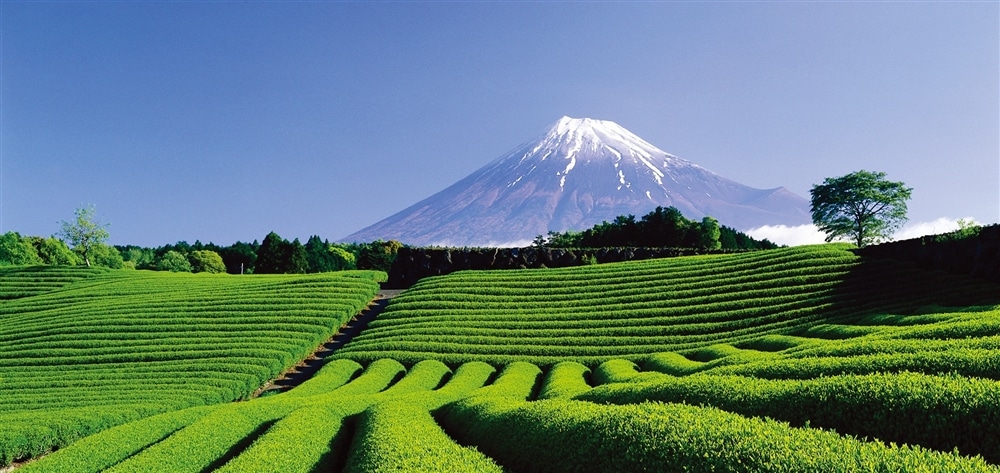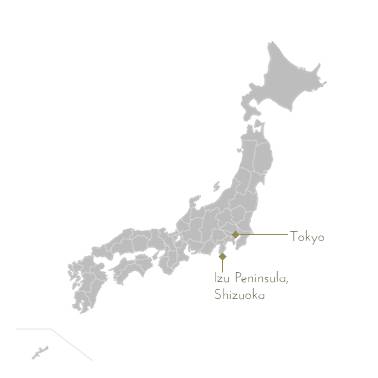

- Take the just debuted luxury express train to travel deep into the pristine landscape south of Tokyo
- Visit a celebrated ‘literary’ onsen town
Day 1
Take the newly launched luxury Saphir Odoriko express train from Tokyo Station to Izukyu-Shimoda Station about 100km southwest of Tokyo (approx. two and a half hours). Deriving inspiration from the French word for “sapphire,” the eight-car train with all “Green Car” or first-class seating offers spectacular views of the blue ocean and sky of the Izu Peninsula in Shizuoka Prefecture. The town of Shimoda is where the building of a modern Japanese state began when, in 1853, Commodore Matthew Perry of the US Navy, the commander of the East India Operation Unit, arrived with fleet of “Black Ships” and demanded the opening of Japan. Wander through and soak in the 19th century ambience of the charming historic town. Enjoy short sake tasting at a brewery dating back a century. During the rainy season (typically lasting from early June until mid-July), Shimoda draws visitors from around the world for Japan’s largest Hydrangea Festival. Transfer by private vehicle to the town of Kawazu with your guide on hand. End the day by indulging at a sensual, age-old ryokan with a hint of western modern created by a world-renown Japanese interior designer. Dine on a refined “Nouveau Japanese” dinner course that is a surprisingly perfect harmony of “east meets west.”
Day 2
Cherry blossom viewing is a rite of spring in Japan. The town of Kawazu, best known as the place where kawazu-zakura originated, is just half an hour drive from Shimoda. Kawazu-zakura, the first to herald the arrival of spring, are the dramatic, eye-catching harbingers of spring, bursting into bright pink blooms in February well before all other types of flowering cherry trees start to blossom in Japan. If you arrival falls into other seasons, take a leisurely 1.5km walk along a serene river trail and enjoy a series of seven, awe-inspiring waterfalls called Kawazu Nanadaru recommended by the Michelin Green Guides. Then transfer to the town of Matsuzaki. Featuring the famed namako wall with its distinguished white grid pattern on black slate, this quaint little coastal village retains an ambience of a 19th century rural hamlet and offers a glimpse into local life. It is also the only place in the Izu Peninsula where you can take a joyous rickshaw ride. Transfer to the town of Shuzenji. Known as “Little Kyoto” of the peninsula, historic Shuzenji is located in the heartland of the beautiful, lush cape, offering everything you would expect from one of the most admired hot-spring towns in Japan, from red-lacquered bridges and a bamboo forest path to a centuries-old temple and a foot spa. After taking a leisurely stroll, enjoy a sumptuous shojin dinner course at a ryokan held in highest esteem in Japan.
Day 3
The day is all about soaking in the splendor of Mount Fuji, Japan’s highest and grandest peak. Kick off your day at one of the most sought-after spots for strikingly picturesque views of Mt. Fuji and green tea fields. The Micheline-Greened Ohbuchi-Sasaba district of Fuji City in Shizuoka Prefecture is a mecca for the production of green tea. Hardly anything is more dazzling than seeing layers upon layers of immaculately manicured tea fields stretching into the horizon with the peak of the sacred mountain farther in the background. Roll up your sleeves and join the local farmers for fun-filled tea leaves picking (the new leaf harvest season runs from May to October) followed by a tasting of freshly brewed green tea. Their refreshing aroma and smoothing taste is without question one of the highlights of the day. Then make a quick stop at the Fujisan World Heritage Center, a one-stop information center to learn all about the history and heritage of Mt. Fuji and mountain worship. Transfer to Fujisan Hongu Sengen Taisha. Serving as the head shrine for more than 1,300 subsidiary shrines across the country, the shrine was built in the 9th century to hold power over an erupting Mt Fuji. The shrine exudes the sacredness, wonder and awe that people have long come to associate with the mountain. End the adventure-filled day by either making a beeline for Shizuoka Station, an hour drive, to take Shinkansen bound for Kyoto, or heading out for Shin-Fuji Station, a 40-minute drive, and return to Tokyo.
The Izu Peninsula is rich with leisure and fun, from the famed and the cultural to the adventurous. The peninsula is home to a myriad of attractions, from the historic town of Shimoda and Japan’s largest hydrangea festival to famed kawazu-zakura and the celebrated, Zen-inspiring ‘literary’ onsen town of Shuzenji. The region is one of the top ranked destinations for onsen and scenic countryside, not the least of which is majestic Mount Fuji. The Izu Peninsula invites you to experience its wealth of nature, culture and culinary delights. Come explore!